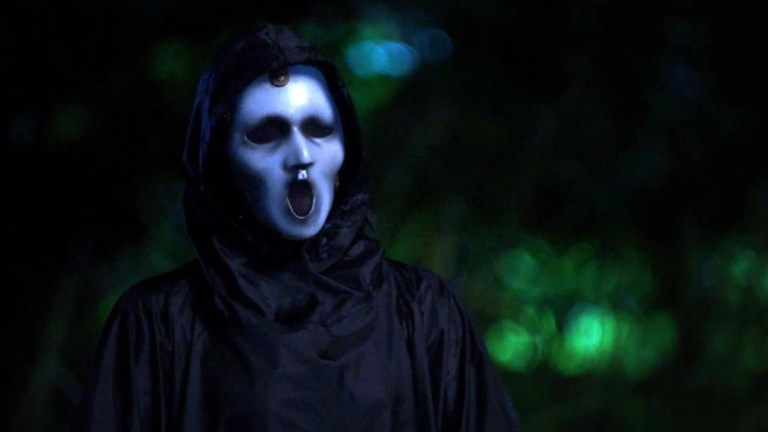Why The Scream TV Series Just Didn’t Work
It's time for Scream TV shows fans to acknowledge that it just wasn’t quite the same as the real thing.

This article contains spoilers for Scream: The TV Series and the Scream film franchise at large.
The mid-to-late ‘90s was a strange time for film and television, and things were especially bleak for horror fans. Sure, there were the classics from the ‘70s and ‘80s to fall back on, but ironically, those same franchises were almost the ruin of the genre for an entire decade.
By the mid ‘90s, the horror movie genre was all but dead, mostly in part to a myriad of iconic horror franchises that outstayed their welcome, such as Friday the 13th, Halloween, and A Nightmare on Elm Street. Much maligned sequels kept being released, but no one came to see them, and it was clear the slasher sub genre needed a shot in the arm.
…Or a knife in the chest?
Coincidentally, it was iconic director Wes Craven, teaming with a relatively unknown screenwriter at the time named Kevin Williamson who would resurrect the genre and once again get audiences gathered together to watch teenagers run in a futile fashion from a masked maniac. Scream (1996) seemed to fill a void, being part homage to old school favorites, and giving us our first memorable taste of meta-filmmaking in a long time.
After Williamson went on to a successful career in film (penning I Know What You Did Last Summer and several Scream sequels), and became a mega-hit creator in television as well (Dawson’s Creek, The Vampire Diaries), things eventually came full circle for the Scream franchise in 2015. Before yet another resurgence in 2022’s “requel” Scream, there was Scream: The TV Series.
Looking back at the MTV series now though, it’s tough to count it among the best the Scream franchise has to offer. Though it was far from good television, it may have been properly timed.
The Format Changes Everything
In the very first episode, series resident film nerd (a must in any Scream installment) Noah Foster (played by John Karna) tells his classmates that “You can’t do a slasher movie as a TV series” giving the younger MTV audience a taste of what Williamson would often do, poking fun at the genre, the limitations of filmmaking, and being self-referential.
The irony is: Noah was right.
The character laid out exactly what would soon become the major weak points of the series. For one, “Slasher movies burn bright and fast”, and yet here was a show with a 10-episode first season, which then spawned a second season renewal, a made for TV movie, and a shortened third season. For most of that time, it was the same story. That’s a slow burn for a genre that is supposed to get your heart rate up.
True fans of the genre quickly recognized that this show was barely a fit for the slasher genre, as on average the writers would give you one or two deaths, and almost always were those deaths in the first 10 or final five minutes of an episode. By the time the season is over, after hours of storytelling, the endings for all three seasons were anticlimactic. In fact, the pace was the most deadly killer within the show.
That also meant there was a lot of time to fill, and there were two major issues with that pacing. Most prominently, the showrunners decided to make the series more akin to The O.C., or more accurately Pretty Little Liars. It was caught up in teenage drama, rumors and bullying, and this was never the strength of any slasher movie. The genre, of course, typically caters to younger people, and predominantly features younger characters, but not to relive the same day they just had in high school before coming to the theater. Slashers should be a dark cathartic escape.
The Characters
While some of the characters fit the archetypes of the genre well, most notably “Final Girl” Emma (Willa Fitzgerald), there weren’t too many standouts as characters you could really cheer for. This goes hand in hand with the format.
The TV series format allowed for more time to get to know these characters, which as archetypes, are typically nothing more than a certain sized peg to fit into a certain sized hole. When suddenly given layers, they almost always became too much. The constant twists and turns in terms of who was an antagonistic character, and who was a hero, who was redeemable, and who was pure evil became frustrating, or often the characters became too big and melodramatic.
Noah, a clear homage to Randy (Jamie Kennedy) from the original Scream films, was clearly meant to be the staple all Scream installments need – a pop culture obsessed nerd who is the one to throw out meta movie analogies and references that Williamson made so popular. But because a television show needs so much more out of a character, Noah became an all-encompassing almost omnipotent nerd figure: he was a hacker, he was a STEM genius who could triangulate satellites and track smartphones, and he worked at a comic book store. Granted, Randy worked at a video rental place in the original film, but he stayed in his lane. The writers of the show merely made Noah and so many other characters fit their needs to push the story forward, rather than make them believable.
This constant change in tone, motivation and morality created so many characters that were difficult to get behind and root for. No longer were Scream fans given loveable fan-favorites such as Dewey (David Arquette), instead we had to cherry pick certain moments to actually cheer for a character, and hope it would last.
The Writing
Even if you enjoyed the show and could overlook the characters dialed up to 11, or the melodramatic teen romance, if you are a true Scream fan, you have to admit, it was missing one key aspect within the writing. Subtext.
The most successful chapters in the Scream films (and of course this is up for debate) often have very interesting and topical subtext to the motivation of the killers. This is not meant to dismiss Billy (Skeet Ulrich) and Stu (Matthew Lillard) and their original reign of terror, fuelled by Billy’s need for revenge, but as mentioned, the meta aspect of Williamson’s writing has always been one of the strongest keystones to the franchise.
Take for instance Mickey (Timothy Olyphant) from Scream 2, and his defense of movie violence turning him into a psychopath. That film was released in a time of modern-day conservative McCarthyism as American politicians claimed that films and video games were too violent, and two years before the Columbine tragedy when that persecution of pop culture was in full force.
Or the recent duo of Amber (Mikey Madison) and Richie (Jack Quaid) whose rampage was the result of toxic fandom gone too far. Even one of the weaker installments in Scream 4 where Jill (Emma Roberts) went to insane and killer lengths to become the next viral sensation. All very topical magnifying glasses to the modern and scary world of media we live in. Scream showrunner Jill E. Blotevogel has mentioned that she was trying to show the dangers of social media in teenagers’ lives, but it wasn’t an effective subtextual element as it was merely a tool utilized to unravel the mystery, and not a part of the killer’s motivation.
Williamson (and writers James Vanderbilt and Guy Busick with Scream V) never talked down to their audience. They gave us the black mirror to gaze upon and let us draw our own conclusions. The series never did that. Their eventual killers weren’t subtextual, they were merely… textual.
Did It Want to Be the Scream Films, or Not?
In truth, there may have been a myriad of factors that the series had to deal with that a creative legend such as Craven, and the modern horror godfather Williamson wouldn’t have to put up with. Part of the issue is neither one of them was all that involved in the creation or process of the show.
The result was a show that had several homages to different horror classics – the Brandon James plot that was the center of the first two seasons was a mix of the Lumis revenge plot of the original film with spattering of Jason Voorhees. The plot seemed like a watered down version of something Scream fans had already seen. Often the characters suffered. Piper (Amelia Rose Blaire), while certainly one of the more interesting figures in the first season, was merely the light version of Gale (Courtney Cox) with a pinch of Roland (Scott Foley) and his familiar connection in Scream 3. They also teased the angle that Emma’s boyfriend might be the killer for a while, but could only hold out for so long. That trope reared its ugly head in the conclusion of season 2, yet another safe and somewhat predictable conclusion.
If you look closely, you could tell that they were trapped in a no-win situation, trying to be like the movies, but be their own identity as well, and it should be recognized that’s a very precarious situation. Even small details like the redesign of Ghostface’s iconic mask (which Wes Craven himself could not stand) and the casting of Mike Vaughn as “The Voice” seemed like they were trying to be different, but only slightly. Eventually they even corrected both of those changes, reverting back to Ghostface’s original look, and recasting the voice legend Roger L. Jackson in season 3.
Ultimately, the show creators were given carte blanche to create something new, but instead, they wavered between the familiar and what could have been groundbreaking. It really just comes down to accepting what Noah said at least partially true – you certainly can adapt a slasher series into a TV show, but perhaps, you simply shouldn’t.
All three seasons of Scream: The TV Series are available to stream on Netflix in the U.S.
